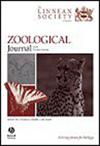全基因组单核苷酸多态性揭示的南美洲捕获后羽鱼种群的低遗传变异性和高隔离性
IF 3
2区 生物学
Q1 ZOOLOGY
引用次数: 0
摘要
在过去的 200 年里,Otaria flavescens 一直是受到最严重开发利用的松狮类动物之一,一些种群的数量减少了约 90%。南美洲禁止海豹捕猎后,除乌拉圭种群持续减少外,其他种群数量趋于稳定。其数量下降的根本原因尚不清楚。这项研究利用全基因组单核苷酸多态性来评估大西洋中一些被过度开发的海狮群落的变异性和连接性。我们的研究结果表明,乌拉圭种群的等位基因丰富度、核苷酸多样性和杂合度都很低,有证据表明它们与所研究的阿根廷种群完全隔离。与此相反,巴塔哥尼亚种群显示出高度的连通性,这可以解释其目前的恢复情况和高水平的多样性。我们的研究凸显了乌拉圭海狮种群的严峻形势,强调了在该地区继续开展保护工作的必要性。本文章由计算机程序翻译,如有差异,请以英文原文为准。
Low genetic variability and high isolation of a post-harvest South American pinniped population as revealed by genome-wide single nucleotide polymorphisms
Otaria flavescens has been one of the most heavily exploited pinnipeds during the last 200 years, with depletion of ~90% in some colonies. After the prohibition on sealing in South America, populations stabilized except for the Uruguayan population, which showed a constant decrease. The underlying causes of its decline are unknown. This study used genome-wide single nucleotide polymorphisms to assess the variability and connectivity of some of the most overexploited sea lion colonies in the Atlantic Ocean. Our results revealed low allelic richness, nucleotide diversity, and heterozygosity in the Uruguayan population and evidence of complete isolation from the Argentinean populations under study. In contrast, the Patagonian populations showed a high degree of connectivity, which could explain their recovery and high levels of diversity at present. Our study highlights the critical situation of the Uruguayan sea lion population, emphasizing the need for maintaining continuous conservation efforts in the region.
求助全文
通过发布文献求助,成功后即可免费获取论文全文。
去求助
来源期刊
CiteScore
6.50
自引率
10.70%
发文量
116
审稿时长
6-12 weeks
期刊介绍:
The Zoological Journal of the Linnean Society publishes papers on systematic and evolutionary zoology and comparative, functional and other studies where relevant to these areas. Studies of extinct as well as living animals are included. Reviews are also published; these may be invited by the Editorial Board, but uninvited reviews may also be considered. The Zoological Journal also has a wide circulation amongst zoologists and although narrowly specialized papers are not excluded, potential authors should bear that readership in mind.

 求助内容:
求助内容: 应助结果提醒方式:
应助结果提醒方式:


